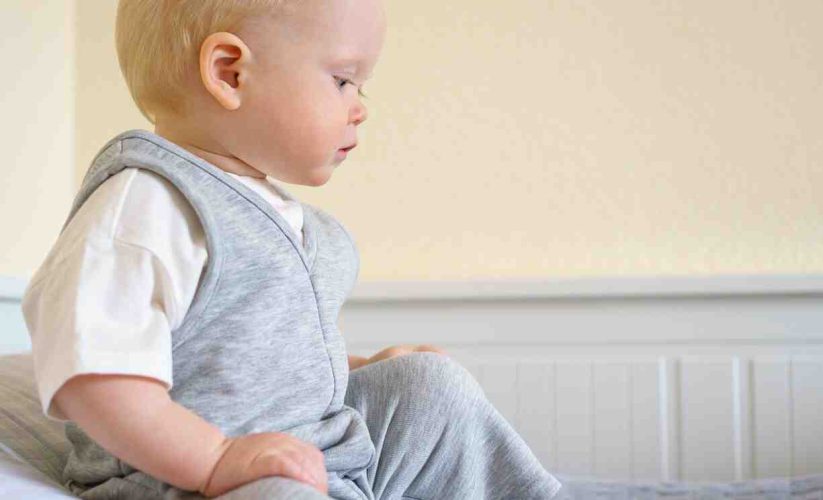
When to Stop Swaddling: Signs Your Baby Is Ready
When to Stop Swaddling: Signs Your Baby Is Ready
Swaddling is a comforting and effective method for soothing newborns, helping them feel secure and sleep more soundly. However, as babies grow and develop, the time will come to transition out of swaddling. Stopping swaddling at the right time is crucial for your baby’s safety and developmental needs. If swaddling continues for too long, it can hinder motor skill development, or pose risks like overheating or suffocation. Here’s what you need to know about when to stop swaddling and the signs that indicate your baby is ready to make the transition.
Why Is It Important to Stop Swaddling at the Right Time?
Swaddling offers numerous benefits in the early stages of a baby’s life. It mimics the feeling of being in the womb, reduces the startle reflex, and helps babies feel safe and calm. However, as babies reach certain developmental milestones, swaddling can become restrictive, prevent them from moving freely, and pose safety risks. The most critical factor in deciding when to stop swaddling is when your baby shows signs of being able to roll over, as swaddling can prevent babies from using their arms to push themselves up or reposition their head, which increases the risk of suffocation.
Signs Your Baby Is Ready to Stop Swaddling
1. Your Baby Can Roll Over
The most important sign that it’s time to stop swaddling is when your baby shows signs of being able to roll over. Around 3 to 4 months of age, many babies start developing the strength and coordination needed to roll from their tummy to their back or vice versa. Swaddling can interfere with this developmental milestone by restricting their arm movements, which could lead to dangerous situations if they roll onto their stomach while swaddled.
Once your baby can roll over, swaddling becomes unsafe because it prevents them from pushing up with their arms or moving their head to avoid suffocation. For safety reasons, it’s essential to stop swaddling once your baby shows signs of rolling.
2. Your Baby Is Busting Out of the Swaddle
Some babies are strong and determined enough to escape their swaddle, and if they start breaking free, it’s a clear sign that they no longer need the tight security swaddling provides. If your baby is able to wriggle out of the swaddle, they may be signaling that they are ready for more freedom of movement.
A baby who escapes their swaddle might also be more likely to accidentally expose their face, which could cause a suffocation risk. If your baby is regularly busting out of their swaddle, it’s time to stop and transition them to a more appropriate sleepwear option.
3. Your Baby Seems to Be Discomforted by Swaddling
While swaddling is usually comforting, some babies begin to resist being wrapped up as they get older. If your baby starts showing signs of discomfort, fussing, or crying when swaddled, it may be a signal that they are ready for more freedom and space. Babies may also start wriggling around more in their swaddle, indicating that they want to move their arms and legs freely.
If your baby seems unhappy or agitated when swaddled, try giving them more space by loosening the swaddle or transitioning to a sleep sack, which provides a similar sense of security but allows for more movement.
4. Your Baby Is Reaching Developmental Milestones
As your baby grows and reaches certain developmental milestones, they will gradually become more active and alert. At around 2-4 months of age, babies typically start gaining more control over their muscles and can begin moving their arms, legs, and head more freely. Swaddling can interfere with these early movements, which are important for strengthening muscles and developing coordination.
If your baby is becoming more active and trying to push up during tummy time, swaddling might be hindering their physical development. It’s important to allow your baby to explore these movements and develop their muscles, which is why transitioning out of the swaddle is important once they start hitting these milestones.
5. Your Baby Is Starting to Sleep Longer
As babies grow, they begin to sleep for longer stretches of time. When they are no longer needing frequent nighttime feedings and can go longer between naps or nighttime sleep, it might be a good time to phase out swaddling. This is because swaddling is generally most beneficial in the early stages when babies need frequent comfort and reassurance. As your baby becomes more independent in their sleep patterns, they may no longer need the snug security of a swaddle.
If your baby is sleeping for longer stretches without waking up to feed, they may be ready to move on to a more appropriate sleepwear option that allows for freedom of movement and comfort.
6. Your Baby Prefers to Sleep with Their Hands Up
As babies grow, they often develop preferences for how they sleep. Some babies enjoy having their hands near their face, particularly as they begin to explore self-soothing behaviors like sucking on their thumb or hands. If your baby seems to prefer sleeping with their arms up or out, it could be a sign that they are ready to move out of the swaddle and into a sleep sack or wearable blanket that allows them more freedom of movement.
Babies may begin using their hands to self-soothe, so it’s important to let them have the freedom to discover and develop this skill. Swaddling can prevent this, so transitioning to a different sleepwear option can be beneficial.
How to Transition Out of Swaddling
When you decide it’s time to stop swaddling, there are several ways to make the transition easier for both you and your baby:
1. Gradual Transition
One method to ease the transition is to gradually reduce the swaddle. Start by leaving one arm out of the swaddle at a time. This way, your baby can get used to having one arm free while still feeling secure with the other arm swaddled. Once your baby is comfortable with one arm out, you can move to both arms out and eventually stop swaddling entirely.
2. Use a Sleep Sack
Instead of stopping swaddling abruptly, you can use a wearable blanket or sleep sack that provides some comfort and security but allows your baby more freedom of movement. Sleep sacks are great because they keep your baby warm while allowing their arms and legs to move freely. Some sleep sacks have adjustable arm holes, so you can gradually make the transition from swaddling.
3. Encourage Self-Soothing
If your baby has been used to being swaddled, they may rely on you to comfort them when they wake up during the night. As you transition out of the swaddle, it’s important to encourage self-soothing. Give your baby the opportunity to learn how to calm themselves by sucking on their thumb, rubbing their face, or simply drifting back to sleep on their own.
4. Create a New Sleep Routine
As part of the transition, you may want to establish a new sleep routine that helps your baby feel secure and comfortable without the swaddle. Consider adding a calming activity like gentle rocking, singing, or reading a story before bedtime to help your baby feel settled.
Conclusion
Knowing when to stop swaddling is an important part of your baby’s development. Pay attention to the signs mentioned above—such as rolling over, breaking out of the swaddle, and showing discomfort with the swaddle—to determine the right time to make the transition. While the process can take some time, with patience and a gradual approach, you can help your baby adjust to sleeping without the swaddle and continue developing healthy sleep habits. Always prioritize safety during the transition and allow your baby the space to explore and grow into their new sleep routine.


